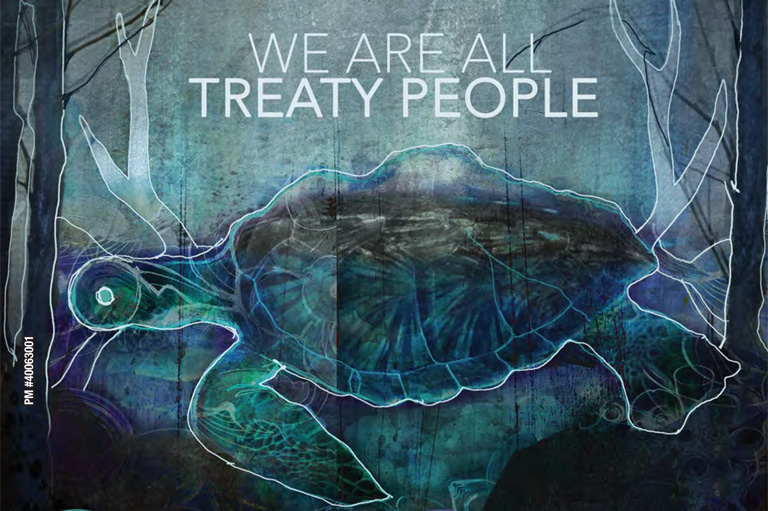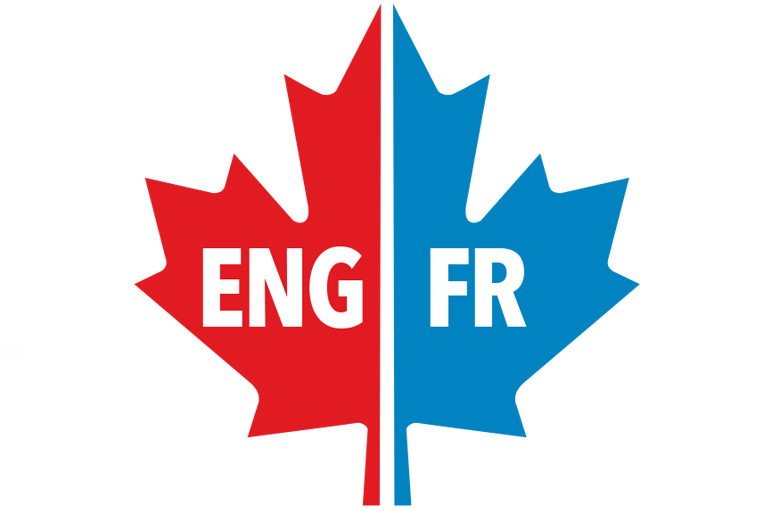Treaties in Canada
This educational package is inspired by Canada in Focus Episode 3: A Promise to Share.
Advice on why it’s important to bring Treaties into the classroom and suggestions on how to do it
Written by Connie Wyatt Anderson, 2014 recipient of the Governor General’s History Award for Excellence in Teaching
The Anishinaabeg word used to explain Treaty is agowidiwinan, which means “bringing things together.” In Cree, kichi-asotamâtowin, “sacred promises to one another,” also describes the Treaty relationship. Treaty relationships were and remain an integral part of Indigenous peoples’ cultures, ways of life, and being. Treaties among First Nations were foundational, serving as unifying links between nations, cementing trading relationships, allowing for passage between traditional territories, and honouring ties of family and extended kinship. They were enduring oral promises which were renewed annually, solidified with prayer and protocols, ratified with handshakes, and made in the presence of the Creator. Treaty-making asserted Indigenous sovereignty, agency, and foresight. Treaties were entered into in good faith, with the aim of ensuring a sustainable and equitable future for ensuing generations.
When European newcomers first came to what is now Canada, these Treaty relationships continued. First Nations entered into Treaty agreements — sacred promises — with Europeans as they expanded across Turtle Island. The Royal Proclamation of 1763 codified the Treaty relationship, serving as a template for Treaty-making in the forthcoming years. This also set the precedent for centuries of Treaties between the Crown (colonial and Canadian governments) and Indigenous peoples; for example, the Peace and Friendship Treaties (1725-1779), the Douglas Treaties (1850-1854), the Manitoba Act (1870) and the Numbered Treaties (1871-1921). On the east coast Treaty agreements were recorded on wampum belts; further west they became guideposts during the fur trade era and served as Métis and First Nations’ entry into Confederation.
First Nations and the Crown had, and continue to have, differing interpretations of Treaties. In the past, when the Treaties were first signed, the Crown regarded Treaties as land sales or surrenders, where Indigenous peoples viewed them as agreements to share the land with newcomers and to preserve their cultures and livelihoods. From the latter’s view, Treaties were oral agreements that remain both evergreen and sacred. The written aspect of Treaties only captures one perspective: that of the Crown’s.
This is why Treaty-making is so important to Canadian history. It is a foundational part of Canadian history — not just Indigenous history. An exploration of Canada’s past would be wholly lacking and one-sided if Treaties were not included. Understanding Indigenous oral traditions, worldviews, and ways of knowing is a key part of the historical skills associated with exploring Canada’s past. Treaties are not historical relics. Modern-day Treaties are still being negotiated and unmet Treaty entitlements are being fulfilled. Treaties still guide us today, making all Canadians Treaty partners.
How can you engage your students in a study of Treaties and Treaty relationships? Have them explore Indigenous worldviews and perspectives, place Treaty-making into the tapestry of Canadian history, talk about Treaties in the present tense, unpack Indigenous terms and vocabulary associated with Treaty-making, help them find their role as a Treaty partner, and use the spirit and intent of Treaties as a bellwether for reconciliation.
More Advice from Teachers
How would you teach your students about Treaties?
Defining terms and map work can be two ways to approach the topic of Treaties. What is a land claim? What are the types of land claims — specific land claim vs. comprehensive land claim? Maps allow students to understand concepts, patterns, and relationships. Students can explore the concept of land claims by mapping the Treaties in their province and of the country. This can provide a way of starting a conversation about the land acknowledgement and what it means.
– Emilia Adorante, Thornhill, Ontario
I have a great resource from the Critical Thinking Consortium, “Sources on the Numbered Treaties.” There are 8 pages of primary and secondary documents about the Treaties. I provide students with 2 documents in pairs and groups. They use the documents to answer:
- Why did Indigenous Peoples sign the Treaties?
- What did they hope to gain? What did they receive?
These questions are answered in the context of understanding the history of settlement and immigration and the different waves of people coming to Canada.
– Jennifer Janzen, Winnipeg, Manitoba
It is important to begin a course and in each unit of study to contextualize where and how the Treaties that were negotiated between Indigenous peoples and non-Indigenous peoples were created, along with what responsibilities each party has as stewards and caretakers of the land. Students need to understand that when Treaties were signed, there were different understandings as to what was being documented, shared and taken over by settlers. Having students look at the Treaty documents as primary source materials, while also using oral histories from Indigenous Treaty partners will help to ensure that students gain knowledge and understand the impacts of Treaties on land use, animals, and on the livelihoods of Indigenous communities who have cared for the land for generations.
Students also need to understand that as settlers, they have responsibilities as Treaty partners to take care of the land and to acknowledge the Indigenous communities who have cared for and maintained the land that they live, learn, and play on today. Having students work with source materials and listen to oral histories allows them to explore the historical and contemporary relevance of these important documents.
– Katy Whitfield, Toronto, Ontario
As a part of the recommendations of the Truth and Reconciliation Commission (TRC), and mandates from educational jurisdictions throughout Canada, schools need to find a way to teach the origins and implications of the Indian Act. One way to do this is to have students take one of the 21 restrictions from the Indian Act and present them to the class examining their purpose, how it has been applied, and what the future could hold regarding reforms to it to make a more equitable Canadian society. A key resource to assist students to do this is Bob Joseph’s book 21 Things You May Not Know About the Indian Act. Related to this, another way to understand the impact of the Indian Act is to analyze the 94 Calls to Action that were a result of the TRC. This unpacking the 94 Calls to Action activity has students research each of the “calls,” what has been achieved, what has yet to be accomplished, and what “action” each of us can make regarding all of them.
– Shannon Leggett, North Vancouver, British Columbia
How do you make Treaty history relevant and engaging for students?
Students can use Native Land to explore the Treaties, territories, and languages of the Indigenous peoples who first settled on and who have cared for the land. Unpacking the purpose and creation of land acknowledgments and their uses as statements by settlers is an important part of the discussion. Students will be familiar with the use of land acknowledgements in their school communities and can be invited to break down the components of the acknowledgement, and identify the lands and peoples, as well as the ways in which the lands are being used. As settlers, they can also work on writing their own land acknowledgements to identify the peoples who first settled and who have continued to care for the land, identifying with gratitude the ways in which they use the lands for their benefit today.
– Katy Whitfield, Toronto, Ontario
More Resources from Canada’s History
Lesson Plans and Activities on Treaty History
Learn More with These Resources
- Key Moments in Indigenous History Timeline, Historica Canada
- Indigenous Peoples of Canada, Canada Guide
- Treaties and Agreements in Canada, Canadian Geographic
- Maps of Treaty-Making in Canada, Government of Canada
- 21 Things You May Not Know About the Indian Act, CBC Article
- Indigenous Education K-12, University of British Columbia
- What do you really know about The Indian Act?, CBC Radio
- Telling Our Twisted Histories, CBC Podcasts
Themes associated with this article
Advertisement

Canada in Focus is made possible through the generous support of The Northpine Foundation.




















